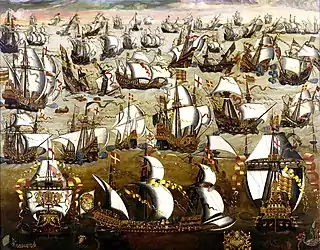English ship Elizabeth Jonas (1559)
The Elizabeth Jonas of 1559 was the first large English galleon, built in Woolwich Dockyard from 1557 and launched in July 1559.
 English ships fight the Spanish Armada, 1588 | |
| History | |
|---|---|
| Name: | Elizabeth Jonas |
| Builder: | Peter Pett, Woolwich Dockyard |
| Laid down: | 1557 |
| Launched: | 3 July 1559 |
| Out of service: |
|
| Fate: | Rebuilt 1597-98. Condemned and sold, 1618 |
| General characteristics as built 1557-59 | |
| Tons burthen: | 740 bm |
| Sail plan: | Full-rigged ship |
| Armament: | 42 guns |
| General characteristics as rebuilt from 1598 | |
| Class and type: | 55-gun Royal Ship |
| Tons burthen: | 684 bm |
| Length: | 100 ft (30 m) (keel) |
| Beam: | 38 ft (12 m) |
| Depth of hold: | 18 ft (5.5 m) |
| Sail plan: | Full-rigged ship |
| Complement: | 500 (340 sailors, 40 gunners, 120 soldiers) |
| Armament: |
|
Construction
The vessel's keel was laid in 1557, for a ship of 800 tons burthen to replace Henry VIII's prestige warship, the Henry Grace à Dieu, which had been destroyed by fire in 1553.[1] Originally intended to be named Edward after Edward VI of England, she was renamed when Elizabeth I came to the throne.[2] She was a square-rigged galleon of four masts, including two lateen-rigged mizzenmasts.
Naval service
Elizabeth Jonas served effectively under the command of Sir Robert Southwell during the battle of the Spanish Armada in 1588. In 1597-98 she was rebuilt as a razee galleon. Phineas Pett mentions that Queen Elizabeth planned to attend the 1598 launch at Woolwich but did not.[3]
On 5 August 1606, held as a day of thanksgiving for the king's deliverance from the Gowrie Conspiracy at Perth in 1600, James VI and I, Anne of Denmark and her brother Christian IV of Denmark had dinner aboard the Elizabeth Jonas at Rochester, and then were rowed to Chatham.[4] Phineas Pett was involved in preparing the Elizabeth Jonas and the Bear for this entertainment.[5]
In the early seventeenth century she was listed as one of the Navy's Ships Royal, denoting the largest and most prestigious vessels in the fleet. A 1618 commission of enquiry confirmed the designation, but found that years of inactivity had left her entirely unserviceable. Later that year she was broken up for scrap at Woolwich Dockyard.[1]
Notes
- Winfield 201, p. 8
- Winfield 2009, p. xii
- Samuel Denne, 'Extracts from the life of Mr Phineas Pette', Archaeologia, Or, Miscellaneous Tracts Relating to Antiquity, 12 (London, 1809), p. 222.
- John Nichols, The Progresses, Processions, and Magnificent Festivities of King James the First, vol. 2 (London, 1828), pp. 82-3, 91.
- Samuel Denne, 'Extracts from the Life of Mr Phineas Pette', Archaeologia, Or, Miscellaneous Tracts Relating to Antiquity, 12 (London, 1809), pp. 229-230.
References
- R C Anderson, List of English Men of War 1509 - 1649
- Rif Winfield, British Warships in the Age of Sail 1603-1714: Design, Construction, Careers and Fates. Seaforth Publishing, 2009. ISBN 978-1-84832-040-6.
- Winfield, Rif (2010). First Rate: The Greatest Warships of the Age of Sail. Annapolis, Maryland: Naval Institute Press. ISBN 9781591142645.
External links
- Warship design site (site appears to be gone!)
- https://threedecks.org/index.php?display_type=show_ship&id=4068